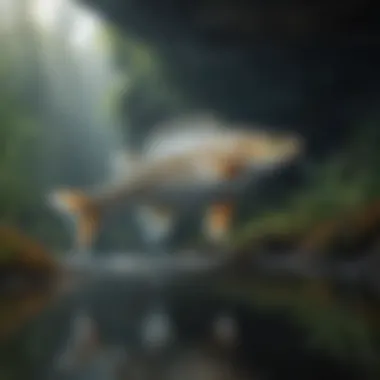Unveiling the Impact of Industrial Fish on Environment and Sustainability Practices


Overview of the Topic
In exploring industrial fish, we embark on a journey to understand the intricate balance between economic necessities and environmental preservation. This exploration delves deep into the realms of industrial fishing, shedding light on its profound effects on the delicate marine ecosystem. It is imperative to recognize the significance of sustainable practices in the fishing industry, not only for current preservation efforts but also for the conservation of marine biodiversity that ensures the well-being of future generations.
Current Status and Challenges
The current state of industrial fishing paints a complex picture of exploitation and environmental degradation. The rampant overfishing practices not only deplete fish populations but also disrupt the delicate balance within marine ecosystems. This exploitation poses a significant threat to the sustainability of marine life, with bycatch, habitat destruction, and ecosystem imbalances simmering as key challenges. The need of the hour is to address these pressing issues and implement effective measures to mitigate the adverse impacts of industrial fishing.
Sustainable Solutions
Amidst the challenges faced by industrial fishing, there exist sustainable solutions that offer a ray of hope for the conservation of marine resources. The exploration of sustainable practices involves a holistic approach towards resource management, focusing on reducing overexploitation, promoting responsible fishing methods, and advocating for ecosystem-based management strategies. Through showcasing successful case studies and examples of effective resource management, we aim to illustrate the tangible benefits of embracing sustainable solutions in the fishing industry.
Impact and Importance
The impact of industrial fishing reverberates across ecosystems, communities, and future generations, necessitating a critical analysis of our actions. The depletion of fish stocks and disruption of marine habitats underscore the significance of conservation efforts and sustainable resource use. Emphasizing the importance of sustainable practices is crucial in safeguarding marine biodiversity, ensuring the resilience of ecosystems, and fostering a harmonious coexistence between human activities and the natural environment.
Introduction
Industrial fish play a crucial role in global food production, but their extraction comes at a cost to our marine ecosystems. This section serves as a gateway to understanding the intricate web of factors at play. By laying a foundation of knowledge about industrial fishing, its impacts, and sustainability practices, readers will embark on a journey towards greater conservation awareness and informed decision-making in the realm of seafood consumption.
Defining Industrial Fish
Industrial vs. Traditional Fishing Methods
The dichotomy between industrial and traditional fishing methods embodies contrasting approaches to seafood procurement. Industrial fishing harnesses mechanized processes on a large scale, often utilizing technologically advanced equipment for efficiency. In contrast, traditional methods lean on artisanal techniques passed down through generations, highlighting a more intimate connection with the seas. This nuanced exploration sheds light on how each methodology influences not only catch yields but also environmental repercussions, shaping the discourse on sustainable fisheries management.
Scale and Scope of Industrial Fishing
The vast scale of industrial fishing operations underscores its significant footprint on marine resources globally. From massive trawlers to sophisticated processing facilities, the industrial sector commands substantial influence over fish stocks and market dynamics. While this industrial prowess fuels economies and satiates consumer demand, concerns over resource depletion and ecosystem disruption loom large. Understanding the scale and scope of industrial fishing sets a pivotal stage for unraveling its multi-faceted effects on the environment and society.
Significance of Industrial Fishing


Economic Importance
The economic underpinning of industrial fishing is indisputable, driving revenue streams, livelihoods, and trade networks worldwide. Beyond its commercial valor, the sector cultivates employment opportunities, infrastructural development, and economic resilience in resource-dependent regions. Nonetheless, the emphasis on profits must align with sustainable practices to avoid long-term environmental degradation and economic volatility. Exploring the economic significance of industrial fishing lays bare its complexities and prompts critical reflections on the delicate balance between fiscal gains and ecological stewardship.
Global Food Security
Global food security hinges on the accessibility and sustainability of seafood sources, with industrial fishing playing a pivotal role in meeting this demand. As a primary protein source for millions, marine catches from industrial operations contribute substantially to dietary diversity and nutritional stability. Yet, challenges such as overexploitation, climate change impacts, and seafood supply chain vulnerabilities pose testaments to the interconnected nature of global food security. Delving into this aspect illuminates not only the urgency of responsible fishing practices but also the intricate interplay between food production, environmental well-being, and human sustenance.
Environmental Impact
In this section, we will delve into the crucial topic of environmental impact concerning industrial fish. The environmental impact of industrial fishing is a pressing issue with far-reaching consequences for marine ecosystems and sustainability practices within the industry. By examining the effects of industrial fish on the environment, we aim to shed light on the importance of adopting responsible and sustainable fishing methods to mitigate these impacts.
Overfishing and Depletion of Marine Resources
Effects on Marine Ecosystems
The effects of overfishing and depletion of marine resources are profound and multifaceted. Overfishing disrupts the delicate balance of marine ecosystems, leading to the decline of various fish species and altering food chains. This depletion not only impacts fish populations but also cascades throughout the ecosystem, affecting marine plants, invertebrates, and other wildlife dependent on a healthy aquatic environment. The unchecked exploitation of marine resources threatens the biodiversity and resilience of marine ecosystems, highlighting the urgent need for effective conservation measures.
Threats to Fish Populations
The continual depletion of fish populations poses a significant threat to marine biodiversity and the sustainability of fisheries worldwide. Overfishing leads to the collapse of fish stocks, jeopardizing not only the species targeted but also those indirectly impacted by disruptions in the ecosystem. The accelerated rate of exploitation outpaces the natural replenishment of fish populations, leading to imbalances that can have long-lasting effects on oceanic health. Understanding and addressing the threats to fish populations is essential in sustainable fisheries management to ensure the long-term viability of marine resources.
Bycatch and Habitat Destruction
Industrial fishing operations contribute to extensive bycatch and habitat destruction, further exacerbating environmental challenges within marine ecosystems. Bycatch, the unintentional capture of non-target species, results in the incidental mortality of numerous marine animals, including endangered species and those vital to ecosystem functioning. Habitat destruction, stemming from destructive fishing practices, alters essential habitats like coral reefs and seabeds, leading to long-term consequences for biodiversity. These unintended consequences of industrial fishing underscore the critical need for responsible and sustainable fishing practices that minimize harm to non-target species and preserve vital marine habitats.
Unintended Consequences
The unintended consequences of bycatch include the depletion of non-target species, increased pressure on fragile populations, and disruptions to ecosystem dynamics. Bycatch not only contributes to species decline but also hinders conservation efforts targeting specific marine species. Addressing and mitigating these unintended consequences require the implementation of measures that reduce bycatch levels and promote the conservation of diverse marine fauna.
Impacts on Biodiversity
The impacts of bycatch and habitat destruction on biodiversity are profound, affecting the stability and resilience of marine ecosystems. By inadvertently capturing non-target species, industrial fishing operations disrupt the intricate web of interdependence among marine organisms, leading to cascading effects throughout the food chain. These impacts extend beyond immediate species loss to broader ecological consequences, highlighting the need for conservation strategies that prioritize biodiversity conservation and sustainable fishing practices.


Sustainability Practices
Sustainability Practices play a pivotal role in the realm of industrial fishing, encompassing a multitude of methodologies and principles that aim to maintain a balance between fish harvesting and the health of marine ecosystems. In the context of this article, Sustainability Practices serve as a cornerstone for addressing the adverse effects of industrial fish on the environment and marine biodiversity. By embracing Sustainability Practices, stakeholders in the fishing industry not only contribute to the preservation of aquatic resources but also ensure the long-term viability of their operations. Through the implementation of sustainable practices, such as responsible fishing techniques and habitat protection, the industry can mitigate the negative impacts associated with industrial fishing while securing a sustainable future for marine environments. Sustainable practices underscore the importance of adopting a systemic approach to fishing management, prioritizing the conservation of marine species and habitats while meeting the global demand for seafood.
Fisheries Management Strategies
Quotas and Regulations
In the domain of Fisheries Management Strategies, Quotas and Regulations serve as essential tools for governing fish harvests and safeguarding marine species. The establishment of Quotas and Regulations involves setting limits on the amount of fish that can be caught within a specified period, aiming to prevent overexploitation and promote sustainable fishing practices. The key characteristic of Quotas and Regulations lies in their ability to regulate fishery activities, ensuring that fishing efforts remain within ecologically sustainable limits. This approach proves beneficial for the fishing industry, as it helps maintain fish stocks at optimal levels and supports long-term fishing opportunities. Despite its advantages, Quotas and Regulations may pose challenges in terms of enforcement and compliance, requiring close monitoring and stringent governance to achieve desired conservation outcomes.
Ecosystem-Based Approaches
Within the realm of Fisheries Management Strategies, Ecosystem-Based Approaches represent a holistic method of fisheries management that considers the interconnections between fish populations, habitats, and ecosystems. By focusing on the broader ecological context of fishing activities, Ecosystem-Based Approaches aim to ensure the sustainable use of marine resources while preserving the overall health of marine ecosystems. The key characteristic of Ecosystem-Based Approaches lies in their integrated and adaptive nature, which allows for a comprehensive understanding of the ecological dynamics at play. This approach proves beneficial for this article as it promotes ecosystem resilience and enhanced biodiversity within marine environments. However, Ecosystem-Based Approaches may entail challenges related to data availability and stakeholder coordination, necessitating robust scientific knowledge and collaborative efforts to achieve successful implementation.
Promoting Responsible Consumption
Certifications and Labels
In the domain of Promoting Responsible Consumption, Certifications and Labels serve as essential mechanisms for informing consumers about sustainably sourced seafood products. Certifications and Labels provide consumers with assurance regarding the environmental credibility and sustainability of the fish they purchase, guiding them towards making environmentally conscious choices. The key characteristic of Certifications and Labels lies in their role as transparency tools, allowing consumers to make informed decisions that support environmentally responsible fishing practices. This aspect proves beneficial for this article as it encourages market demand for sustainable seafood products, driving positive change within the fishing industry. Despite their advantages, Certifications and Labels may face challenges related to certification standards and consumer awareness, highlighting the need for continuous improvements and increased consumer education.
Educating Consumers
Another significant aspect of Promoting Responsible Consumption involves Educating Consumers about the importance of sustainable fishing practices and the impact of consumer choices on marine environments. By raising awareness among consumers about sustainable seafood options and conservation efforts, Educating Consumers plays a crucial role in shaping consumer behaviors towards more environmentally friendly practices. The key characteristic of Educating Consumers lies in its ability to foster a sense of responsibility and stewardship among seafood consumers, empowering them to make conscious decisions that contribute to marine conservation. This element proves advantageous for this article as it aligns with the overarching goal of promoting sustainable fishing practices and safeguarding marine biodiversity. Despite its benefits, Educating Consumers may encounter challenges related to communication barriers and differing consumer preferences, necessitating innovative approaches and targeted campaigns to drive widespread adoption of sustainable consumption habits.
Technological Innovations
In the realm of industrial fishing, embracing technological innovations is paramount for ensuring sustainable practices and minimizing environmental impact. Technological advancements revolutionize the way we approach fishing, offering solutions that promote efficiency and conservation. These innovations encompass a wide range of tools and methods designed to enhance fishing practices while mitigating negative consequences on marine ecosystems. By integrating cutting-edge technology into fishing operations, stakeholders can work towards a more sustainable future for the industry.
Advancements in Fishing Gear
Sustainable Gear Designs


Discussing sustainable gear designs is crucial in the context of industrial fishing. These designs are specifically engineered to minimize the ecological footprint of fishing activities by reducing waste and harm to marine life. The key characteristic of sustainable gear designs lies in their ability to maintain target catches while decreasing bycatch and habitat destruction. By incorporating sustainable gear designs, fisheries can operate more responsibly, ensuring long-term viability and environmental preservation. Although there may be initial investment costs, the benefits of sustainable gear designs far outweigh the drawbacks in promoting a more eco-friendly fishing industry.
Reducing Bycatch
Reducing bycatch plays a vital role in sustainable fishing practices. It involves employing strategies and gear modifications to lower the incidental capture of non-target species during fishing operations. The key characteristic of bycatch reduction methods is their effectiveness in conserving marine biodiversity and minimizing negative impacts on ecosystems. By utilizing techniques such as modified fishing gear and real-time monitoring, fishing activities can significantly decrease bycatch levels. While implementing these strategies may require adjustments and retraining, the advantages of reducing bycatch in enhancing environmental sustainability make it a fundamental component in modern fishing practices.
Data-driven Approaches
Incorporating data-driven approaches is essential for informed decision-making in industrial fishing. By leveraging big data, fisheries can analyze trends, predict stock levels, and optimize resource allocation effectively. The key characteristic of utilizing big data is its capacity to improve resource management and enhance sustainable fishing practices. Through advanced analytics and modeling techniques, fisheries can make proactive decisions to prevent overfishing and promote ecosystem health. While there may be challenges in data interpretation and system integration, the benefits of utilizing big data in guiding fishing activities are substantial.
Tracking Fishing Activities
Tracki Fishing activities Tracking Fishing Activities is key to monitoring and regulating fishing practices for sustainability and compliance. This aspect involves using technology to track vessel movements, fishing locations, and catch data in real time. The key characteristic of tracking fishing activities is its ability to promote transparency and accountability in the fishing industry. By implementing robust tracking systems and electronic reporting mechanisms, fisheries can ensure adherence to regulations and reduce illegal fishing practices. Although establishing comprehensive tracking mechanisms may require investment and coordination, the advantages in improving fishery management and conservation efforts justify the implementation of such data-driven solutions.
Policy and Advocacy
In the realm of industrial fishing and its environmental impact, policy and advocacy play a pivotal role. Within the complex web of factors influencing the sustainability of marine ecosystems, effective policies and advocacy efforts are crucial. Policies serve as the guiding framework, outlining regulations and guidelines for responsible fishing practices. Advocacy, on the other hand, involves promoting awareness and fostering support for conservation initiatives. Together, these aspects contribute significantly to the preservation of marine biodiversity and the long-term health of our oceans.
International Agreements
Role of Organizations like FAO
The Food and Agriculture Organization (FAO) holds a prominent position in shaping international agreements related to fisheries management. As a leading global authority, the FAO coordinates efforts among nations to establish protocols that ensure the sustainable use of marine resources. Its expertise in data collection, research, and policy recommendations significantly influences decision-making processes worldwide. The FAO's emphasis on collaboration and knowledge-sharing makes it a formidable ally in promoting responsible fishing practices and advocating for environmentally friendly policies.
Marine Protected Areas
Marine Protected Areas (MPAs) represent designated zones aimed at conserving marine habitats and safeguarding vulnerable species. By establishing MPAs, countries can protect critical areas from overexploitation and habitat degradation. These protected zones not only serve as sanctuaries for marine life but also support ecosystem resilience and biodiversity conservation. The implementation of MPAs is a strategic approach endorsed by conservationists and policymakers alike for its proven effectiveness in sustaining marine ecosystems.
Community Engagement
Amidst the intricate tapestry of sustainable fishing practices, community engagement emerges as a vital component. By involving local stakeholders and coastal communities in conservation efforts, a sense of ownership and responsibility is cultivated. Such engagement fosters support for sustainable fisheries management and instills a deeper connection to marine resources.
Supporting Local Fisheries
Empowering local fisheries is instrumental in promoting socio-economic development and environmental stewardship. By investing in local fishing communities, governments can enhance livelihoods while encouraging sustainable fishing practices. Supporting local fisheries not only strengthens food security but also fosters community resilience and empowers small-scale fishers to thrive in harmony with nature.
Empowering Coastal Communities
The empowerment of coastal communities is essential for the effective stewardship of marine resources. By providing education, resources, and opportunities for coastal dwellers, a sustainable approach to fisheries management can be fostered. Empowering coastal communities to partake in decision-making processes and conservation initiatives leads to more inclusive and holistic strategies for preserving marine ecosystems and ensuring the well-being of both people and the environment.



